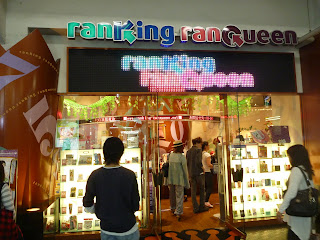The Small Stations
We’ll start off by covering inside our station Mukougaokayuuen, and Harajuku. We take these to be typical and representative examples of the average Japanese train station. Inside these small stations they generally only have things that are necessary, such as things like small convenience stores that sell important items like snacks, drinks, newspapers, and cigarettes for passengers that are transferring. Since many students and office workers have a long commute from home, they often cannot take time out of their schedule to leave the station to look for these necessary items. Depending on the size of the station, there may be several convenience stores inside one station. In addition to convenience stores, there are usually only small food shops that sell quick snacks such as noodles or onigiri. These noodle shops are stand only and there is no room to sit – it’s just grab, gulp down, and run. As well, there are vending machines in various locations throughout the train station, which increase in number depending on the size of the station. In order to pay in these stores and for vending machines throughout the station, you can use your Suica card or Passmo card for added convenience to the passengers (swipe and go).
The Big Stations
The big stations such as Shinjuku and Shibuya however are a completely different story. This has a wide range of implications. Next to the ticket terminals at these big stations the same things that the small stations have are also there (things such as convenience stores, and vending machines). However, these are on a totally different scale. The amount and size of these stores are completely different. And it doesn’t stop there, because the variety of stores also increases tremendously. Things such as bookstores, cosmetic stores, candy stores, and even a flower shop for that special anniversary you forgot about are there. Seeing people standing and reading books around these bookstands and browsing throughout the stores are a common sight.


In particular, Shinjuku is a very special station. Being the final destination of the Odakyuu line, it has built around it and on top of it --- a humungous department store run by Odakyuu! It is composed of several buildings, the tallest of which is 13 floors tall and has a spectacular view! In these department stores you can buy anything you want. There are fully fledged clothing stores, bookstores, restaurants, Starbucks, Crispy Crème, you name it. In the bottom floor of Shinjuku station is something very interesting. It is actually a floor crowded with various stores that sell all kinds of gifts: snack based omiyage from around the country, snack stalls, sweets, and a mini-supermarket that sells fruits and vegetables for the busy commuter on the run.
In front of the stations
What we have already talked about is only one side of the picture, however. Outside of the actual station itself is the busiest part of the whole thing. In the random housing areas there are only small stores and convenience stores - everything is gathered and focused around the station entrances and exits. This is where all the stores you need are gathered to serve the commuting based society. Shoe stores, pachinko, game centers, supermarkets, department stores, restaurants, karaoke, police stations, and clothing stores are all available. This is where people meet up to go out together. Any type of restaurant you want is available – ramen, soba, udon, washoku, McDonalds, KFC, Chinese, places to drink (including nomihodai), donut shops, etc. These are the stores that get the most business on a day to day basis because of their location next to the station.

Cultural Differences between Japan and Canada
In Canada, the station is only for the train, buses, and car parking. There usually aren’t even any vending machines. It is totally bare, and besides not having anything inside the station, there also is hardly anything in the area around the station either. Because in Japan not many people own cars, all the space needed for car parking in Canada is completely forgone. In addition to this, the size of the stations and the number of trains and train cars, and the number of different connecting train lines is completely different. Because in Canada there are only two lines, the size of the station is very small. As well, from station to station the size is always the same (just enough for the train itself). A stark difference in size such as Harajuku versus Shinjuku is something that Canadians have never experienced in Canada. While in Canada there may be a lineup of cars outside the station waiting to pick people up, here in Japan such a thing is not common. While there are often taxis waiting around the station for potential passengers, instead of a car parking lot there is a bicycle parking lot. It is a culture that is based on a different form of travel. While Canada is based on cars, Japan is based on bicycles, walking, and the various train lines that connect the Tokyo metropolis very efficiently and the stores that surround these stations.
No comments:
Post a Comment